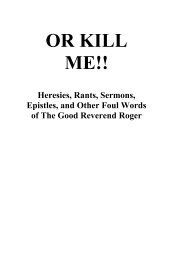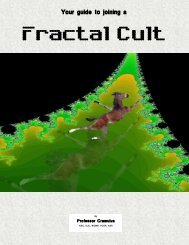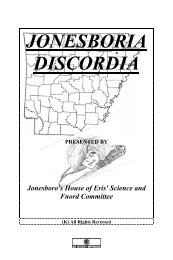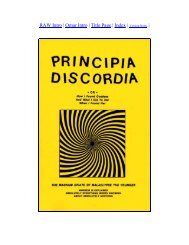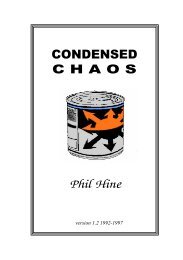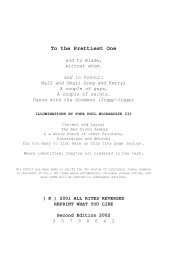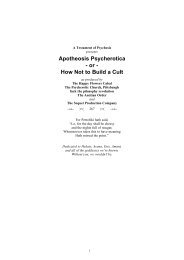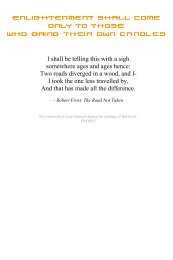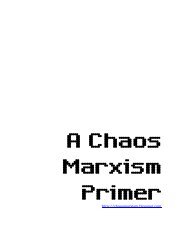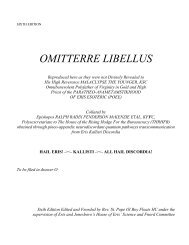Coincidance - Principia Discordia
Coincidance - Principia Discordia
Coincidance - Principia Discordia
You also want an ePaper? Increase the reach of your titles
YUMPU automatically turns print PDFs into web optimized ePapers that Google loves.
96 COINCIDANCE<br />
"mere coincidence"? We are privileged to peep into the mind of a typist<br />
named Martha (who works part-time for Blazes Boylan) but we don't know<br />
if she is thinking about Bloom or about the hero of a novel she has been<br />
reading. Since Bloom's thoughts, like everybody's, contain wishful thinking<br />
and self-deception, we cannot believe him totally, but the other narrators<br />
are so prejudiced pro-Bloom or anti-Bloom that we can't trust them either.<br />
We have seen Reality and found it an abyss indeed; Blake only claimed to see<br />
infinity in a grain of sand, but Joyce has shown us the infinity by opening<br />
every hour of an ordinary day to endless interpretations and re-interpretations.<br />
Things become even more interesting, and weirder, when we begin to<br />
count the coincidences in this very, very average day: a day so banally<br />
normal that early critics complained chiefly that many chapters are boring<br />
and pointless. On the first page. Mulligan is performing a parody of the<br />
Catholic Mass* and whistles to summon the Holy Spirit; a mysterious<br />
returning whistle answers from the street. Mulligan, a devout atheist, is not<br />
impressed by this coincidence, but it is the overture to a rising crescendo of<br />
synchronicity throughout the day. A few pages on, Mulligan mentions<br />
working at the Mater hospital; Bloom lives on the same street with that<br />
hospital. Mulligan then talks of a friend named Bannon who is courting a<br />
girl in a photo shop in Mullingar; at the same time, but three chapters away<br />
in the text, Bloom is reading a letter from that girl, who happens to be his<br />
daughter, Milly. Bannon arrives in Dublin at 11 that evening, just in time to<br />
see the meeting of Stephen and Bloom in conjunction with another<br />
appearance of the enigmatic man in the brown mackintosh. Moses is the<br />
topic of conversation in the newspaper immediately before and after Bloom<br />
enters, and when Bloom arrives at the library two hours later, Mulligan<br />
anti-semitically calls him "Ikey Moses"; at the end of the day, Bloom<br />
suddenly guesses the answer to the child's riddle, "Where was Moses when<br />
the candle went out?" Other coincidences connect Bloom and Moses<br />
throughout the day; a secondary string of synchronicity links bloom with<br />
Elijah; a third famous Jew, Jesus, gets linked to Bloom in Chapter 12, where<br />
the narrator's favorite oath is "Jesus" and the Citizen threatens to "crucify"<br />
Bloom.<br />
Weirder and more wonderful: in the newspaper office, Bloom reflects<br />
that William Braydon, the editor, looks like Jesus and then remembers that<br />
Mario "the tenor" also looked like Jesus. Giovanni Matteo Mario (1810-1883)<br />
was famous for looking like most popular portraits of Jesus, but equally<br />
renowned for his role as Lionel in Flotow's opera, Martha. Jesus was associated<br />
And don't forget that the climax comes when Bloom and Stephen share the<br />
"massproduct," Epp's cocoa.



